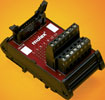Interface modules for interfacing control systems to field devices
17 May 2006
Interconnection

The 39170 series interface modules from Molex is claimed to provide a cost-effective method to interface field wiring to PLCs and other control devices. Intended for machine builders, manufacturers of capital equipment, system integrators, electrical design firms and panel builders, these DIN-Rail mounted devices connect a high-density cable from a PLC or electronic control system to terminal blocks where wiring from field devices is terminated.
The result is reduced wiring time and decreased checkout and troubleshooting time, since the connections between the high-density PLC cable and the terminal blocks are prewired on a printed circuit board.
Molex says that the benefits customers will see from using the interface modules include:
* Reduced wiring time by up to 50%.
* Quicker checkout of new control systems and faster troubleshooting of installed systems.
* Space savings of up to 60% compared to standard DIN rail terminal blocks.
* Lower total installation cost.
The interface modules support from nine to 50 circuits per module, and offer design flexibility with a choice of connection methods. The modules are available with fixed or pluggable terminal blocks, and the PLC/controller interface is available with a ribbon cable connector or a D-sub connector. Clear terminal markings help eliminate wiring errors, and reliable connections are assured using rising cage clamp technology.
Molex can also customise the interface modules with the specific components or connectors needed for high volume OEM applications. Electrical components that can be added include resistors, capacitors, diodes, and LEDs.
Further reading:
Prefitted junction box solutions
Interconnection
Prepopulated junction boxes in popular terminal configurations, such as single- and three-phase, enhance convenience for both electrical wholesalers and contractors.
Read more...
Bulgin unveils new range of sustainable connectors
Avnet Abacus
Interconnection
The Standard Vitalis Buccaneer range of waterproof connectors is a bio-based alternative to Bulgin’s flagship series, the Standard Buccaneer, offering the same technical performance with improved sustainability.
Read more...
Possible copper cable crisis looms as global demand soars
Interconnection
With the world requiring up to 3 billion metric tons of copper by 2050 to support green energy transitions and developing nations’ infrastructure, far exceeding the 23 million metric tons mined in 2024, pressure on supply chains is mounting.
Read more...
High-reliability spring-loaded interconnects
Spectrum Concepts
Interconnection
These springs from Mill-Max are drop-in replacements for the standard springs, requiring no changes to the form or fit of the existing spring-loaded pins.
Read more...
Anoison PCB mount connectors for high-performance applications
Conical Technologies
Interconnection
With its wide selection, Anoison provides PCB mount connectors that combine precision, durability, and cost-effectiveness across industries.
Read more...
Connectors for the Smart Factory
Spectrum Concepts
Interconnection
[Sponsored] Designing networks for the smart factory can seem daunting, but the solutions are already available with Samtec providing a comprehensive range of interconnect technologies tailored to the demands of the modern factory.
Read more...
Mouser shares expert design solutions for advanced robotics development
Interconnection
Mouser Electronics has announced a new interactive eBook, ‘The Electric Workforce’, in collaboration with electronics manufacturer and connectivity innovator, Molex.
Read more...
Explosive zone connectors
Interconnection
The connector series design by Glenair is optimised for fast and easy crimp-contact wire termination, with ample wiring space in the cable housing and accessory hardware.
Read more...
Reliable photovoltaic adapter set
Phoenix Contact
Interconnection
Phoenix Contact’s PV-AS-MC4/6-150-MN-SET1 is a high-performance photovoltaic adapter set designed to bridge SUNCLIX connectors with MC4 connectors.
Read more...
Liquid cooling connectors improve thermal management
Startech Industrial
Interconnection
The leak-free design and high flow rate of both series from Amphenol make the connectors ideal for high-reliability equipment that employ liquid cooling.
Read more...


